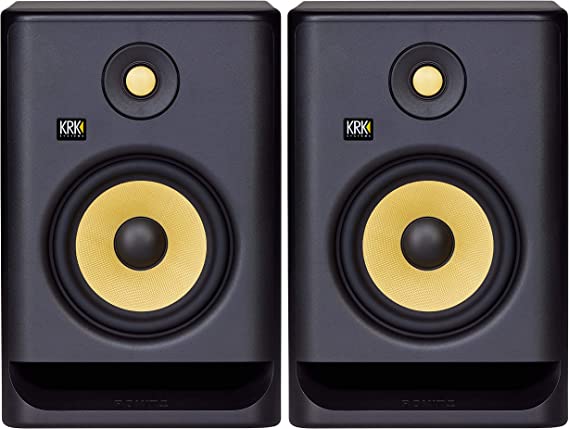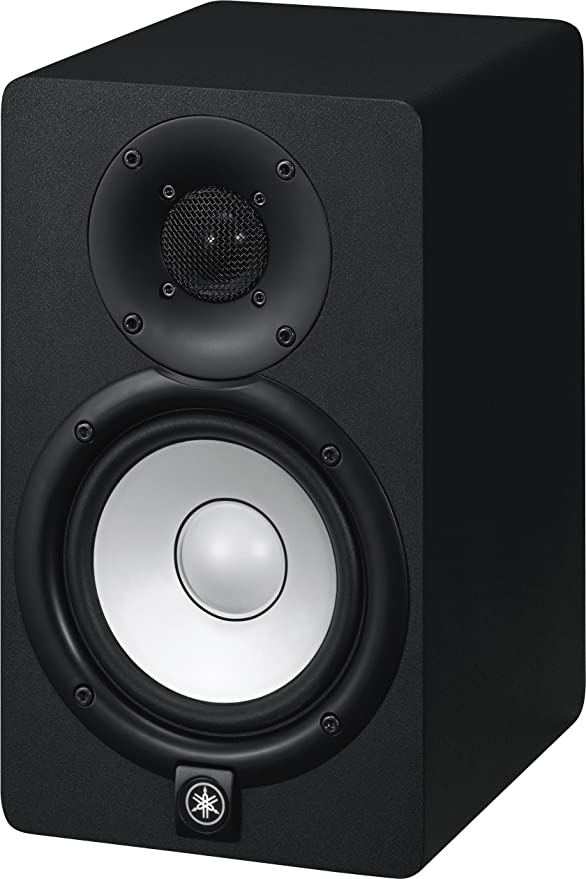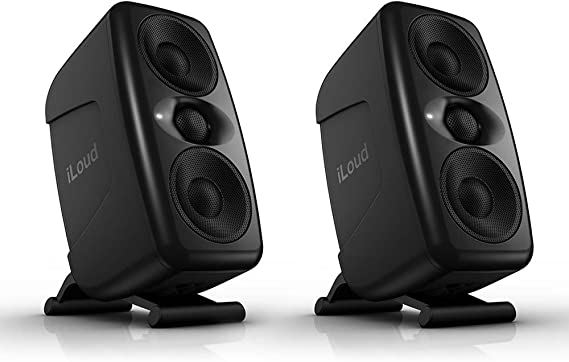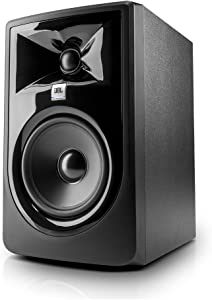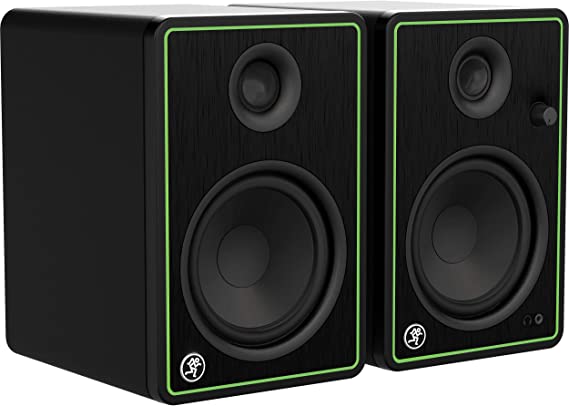Any home producer will tell you that investing in the top studio monitors you can afford can significantly enhance your mixes. In essence, the most excellent small studio monitor speakers are made to accurately portray the sound you’re producing.
Table of Contents
Best Small Studio Monitors
Small monitors are a cheap replacement for typical studio monitors in studios with limited space and money. Just like their bigger counterparts, these monitors are flat and responsive. In this article, you will learn about all the desirable features you should look for in your small studio monitors, and we will present you with a list of the best monitors available on the market.
Check also: Best Gaming Monitors
1. KRK Rokit 7 G4
The likelihood is that you are familiar with the renowned yellow speaker cones of KRK if you have ever entered the studio space of an EDM producer. The cheap nearfield line of the Gibson-owned firm is the Rokit series, which is currently in its fourth iteration. It includes many clever features that make it noteworthy.
The G4 monitors family provides a visual EQ feature within a nice budget bracket on the actual device. To ensure that their output balances out any acoustic blind spots you might be inadvertently harboring in the space you’re mixing in, the speakers’ built-in digital signal processing (DSP) offers various capabilities, including a room analyzer.
Key Features:
- 42 Hz – 40 kHz frequency response
- 2-way speaker configuration
- Tweeter type: Kevlar
- Inputs: Combo input XLR / 6.3mm balanced jack
- Custom Class D power amplifier
- DSP-driven Onboard EQ with Visual LCD
Pros:
- Graphic EQ at this outlay is excellent
- Bass sounds are especially remarkable
Cons:
- Compared to electronic music production, some monitors are better suited for non-electronic music.
2. Yamaha HS5
Yamaha’s renowned NS-10 monitors have earned them a particular position in professional recording facilities. These have been out of production for a long time but are still in great demand since if a mix sounds good on them, it probably sounds excellent everywhere.
In terms of price and performance, the Yamaha HS5 studio monitors are a terrific choice for studios. This history is further reflected in the lowest speaker size offered by the HS5 within the HS series monitors. The HS series provides excellent precision and little coloration with freshly developed bi-amplified drivers and precisely ported enclosures.
Key Features:
- Featuring a 5-inch cone woofer, a 1-inch dome tweeter, and a 2-way bass-reflex bi-amplified nearfield studio monitor
- 54Hz – 30kHz (-10dB), 74Hz – 24kHz (-3dB) frequency response
- Response controls for ROOM CONTROL and HIGH TRIM
- By using attenuators, you can customize the sound of your space
- Inputs from both XLR and TRS phone jacks can be balanced or unbalanced
Pros:
- Value for money performance
- Iconic Body Design
Cons:
- No Bluetooth and EQ
- Controls are located at the backside
3. IK Multimedia iLoud MTM
The iLoud MTMs, IK’s newest addition to its expanding monitor lineup, are stuffed with technology that belies their affordable price tag. A 1″ tweeter is sandwiched between two 3.5″ mid-range woofers in this D’Appolito arrangement, which also has a bass reflex opening on the rear. All of it is DSP-controlled and can be adjusted to match your environment owing to IK’s unique ARC calibration system, which is built right into the speakers and the gauging mic that is part of the package.
This updated model has greater power, deeper bass, and superior audio quality. The robust two-way speaker systems are grounded by low-resonance molded casings, and the 3′′ neodymium drivers include bass ports to reproduce frequencies as low as 55Hz. The iLoud MTM is an amazing option for people with little desk space or who want a surgical backup pair to their primary “fun” monitors.
Key Features:
- The frequency response is ultra-flat and phase-coherent, while the low end is ensured to be controlled and extended
- 40 Hz to 24 kHz frequency response and 100W RMS total power per speaker
- Digital calibration is fully automated and integrated
- 1x combo XLR-1/4” TRS balanced input with 1/8” TS ARC microphone input
- 0° – 20° tilting podium for flawless positioning
Pros:
- Superior sound at short distances
- In-built calibration system
- Ideal for desks and small rooms
Cons:
- Unusable in a large room
4. JBL 305P MkII
For many years, JBL has been regarded as one of the top brands in audio. For those searching for a powered, active compact studio monitor, this manufacturer provides a fantastic nearfield answer in the form of the JBL 305P MkII. It is a superb nearfield option for any professional sound engineer or music composer. You’ll hear more depth and ambiance in recordings thanks to JBL’s patented Image Control Waveguide, which offers detailed imaging and a wide, room-friendly sweet spot. Even in a busy mix, little nuances may be heard. With balanced XLR and 1/4′′ TRS inputs, volume control, and a +4 dBu/-10dBV input-sensitivity switch, the 305P MkII also offers a versatile connection. In our opinion, these monitors are very well constructed and long-lasting. Although you may wish to place them on a shelf or monitor base for ear height, they have a rubberized base that makes them perfect for desktop positioning. The JBL 305P MkII is a good option if you want to maintain monitoring accuracy but have limited room.
Key Features:
- Next-generation JBL transducers, improved boundary EQ, and a modern, streamlined design are all included in the MkII range
- HF and LF transducers have new design advancements that lead to enhanced damping for enhanced transient response and outstanding deep bass with less harmonic distortion
- Integrated custom Class D amplifiers for 82 watts of power
- When speakers are positioned next to walls and on work surfaces, the new boundary EQ maintains a neutral, low-frequency response
- With a broad sweet spot, you can fine-tune your mix while listening off-axis
Pros:
- Incredible stereo imaging
- Enhanced linearity and better transient response
- The sleek, trendy design delivers a theatrical flair to any studio
- Includes renowned JBL performance
Cons:
- Gives a low hiss when not used due to internal impulses
- The input-sensitivity switch is too deeply embedded to be used by hands
5. Mackie CR5-XBT
Even though Mackie’s HR Series professional monitors have been everywhere for more than two decades and have a loyal following, more than $1,000 is required for each pair of their six-inch HR624 Mk2 variant. Our recommendation is the 5-inch woofer that produces a strong bass response since Mackie emphasizes the bottom end more than other manufacturers. The CR5-XBT seems sturdy and superior to other low-cost alternatives in terms of build quality, and it has a wood cabinet that adds weight without making the enclosure overly hefty. With a redesigned rear-ported design and class D amplification, the new XR series cuts that cost by about a third. The XR624 is especially striking for guitar-heavy tunes, which may be a difficult test by even the best speakers, despite its less spectacular bass extension. The CR5-XBT is a compact, dependable monitor that will work well without breaking the budget.
Key Features:
- Flexible inputs – 1/4”, RCA, and Bluetooth
- Outputs: 1 × 1/8′′ bare wire connectors (+/-) (connects pair)
- 5″ Polypropylene-coated woofer and a 0.75″ silk-dome tweeter with ferrofluid cooling
- Frequency response of 50 Hz to 20 kHz (-10dB)
- Class AB 80 W total power
Pros:
- Amazing build quality
- An all-wood cabinet gives the sound a genuine character
- Comes with foam isolation pads
- Impeccable balance across various frequencies
Cons:
- Bass extension is not as good as XR824
Product Guide
The most authentic, unedited rendition of your music should be achievable through your studio monitor speakers. An acoustically transparent monitoring solution guarantees that your mix will sound good on headphones, TVs, automobile audio systems, and other listening systems, whether you’re recording, producing, mixing, or finalizing audio. We’ve put up this guide to assist you in finding the finest selections for your studio space since there are other factors besides accuracy to take into account when choosing studio monitors:
- Power
The system’s power management will significantly impact the entire sound in a studio monitoring system, not simply in terms of volume. As a result, you will have an excellent dynamic range or the amount of headroom you have before signals peak. Higher wattage enables you to hear more transient details and allows you to tweak amplifiers, filters, and gates more precisely.
- Cabinet
Many small studio monitors and a significant number of bigger ones include a ported enclosure that aids in extending the frequency response down for additional bass. The acoustic accuracy of port cabinets may not be as exact as that of closed cabinets, even though this can be advantageous.
If the terminals are on the backside of the speakers and they are put too near to a wall, this tendency is accentuated. For more precise monitoring, you might wish to use front-ported or closed designs if you can’t resist placing your studio monitors next to walls or corners.
- Woofer
Monitors require an amplifier since the electrical signals leaving a small studio mixer or stereo interface are often relatively weak. The amplifier is built within the speaker with active monitors, but it may also be used separately and remotely with passive speakers.
- Placement and Isolation
When you are seated in your mix position, place a stereo set of studio monitors, so they create a triangular shape with your head. As a consequence, the stereo picture will be the cleanest, and the frequency response will be the most precise.
When compared to setting your monitors directly on a desk or mixing panels, speaker stands make your speakers sound better. The precision of your monitor will be decreased since sound reflected from the surface or panel will reach your ears somewhat later than the direct sound.
FAQ’s
Q1.How should studio monitors be placed?
Ans: The woofer’s diameter determines the size of the monitor. Depending on the nearfield monitor, this can range from three to eight inches. Nearfields are sufficient for the majority of small to medium rooms. On the other hand, midfield monitors should be positioned farther out, farther apart, and in a larger space.
Q2.How to test new studio monitors?
Ans: A quality pair of studio monitors should be able to pick up every nuance in a well-known mix. Studio monitors should play back the original mix in all its splendor by having a flat frequency response that is neither colored nor enhanced in any way. The mentioned frequency response should be as wide as possible since this will ensure that the speakers can reproduce all the highs and lows you anticipate from your music. The monitoring of studio monitors can also be done by listening to reference music instead of examining them electronically. It includes your dependable mixes of songs that you are very familiar with. This helps you understand whether any frequency ranges have been boosted or reduced.
Q3.Is a Subwoofer required?
Ans: It all depends on what you’re trying to do with audio. A multi-speaker monitoring arrangement with a subwoofer is necessary if you’re mixing music for TV or movies. You require a stereo set of studio monitors if you’re mixing your band’s basement-recorded demo songs. The layout of your room is another factor. Smaller spaces are insufficient for bass frequencies to develop fully without going into the math. You’ll hear loudness spikes and dips throughout the space if you place a subwoofer there. Some bass notes will sound robust, while others will sound hazy and unclear, and your studio’s overall sound will be out of balance.
Wrapping Up
From affordable alternatives to professional-quality monitoring equipment, we’ve compiled what we believe to be some of the most incredible studio monitors now available on the market, along with the best pricing currently available online. Each of the small studio monitors listed above has achieved popularity through the robust performance it delivers. I hope this article was helpful in briefing you on the latest and best small studio monitors for your home.

Kiran Kotte is a 25 years old Youtuber. He is a tech geek and also codes sometimes. He writes on various topics like Technology, Blogging, Web designing, and SEO. He runs various other blogs under various niches.

